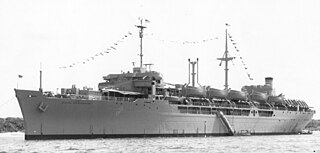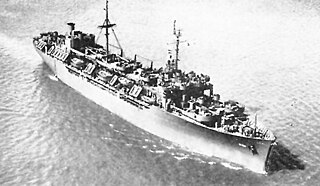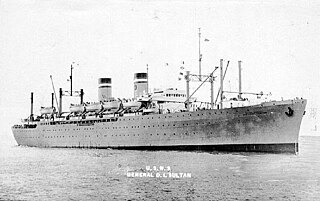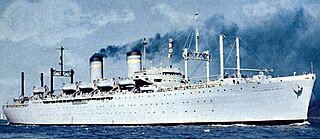
USS General J. H. McRae (AP-149) was a General G. O. Squier-class transport ship built for the United States Maritime Commission during World War II. In 1946 she was transferred to the US Army and operated as USAT General J. H. McRae. On 1 March 1950 she was transferred to Military Sea Transportation Service and operated as USNS General J. H. McRae (T-AP-149). She was named for US Army Major General James H. McRae.

USS General Stuart Heintzelman (AP-159) was a General G. O. Squier-class transport ship for the U.S. Navy in World War II. She was named in honor of U.S. Army general Stuart Heintzelman. She was transferred to the U.S. Army as USAT General Stuart Heintzelman in 1946. On 1 March 1950 she was transferred to the Military Sea Transportation Service (MSTS) as USNS General Stuart Heintzelman (T-AP-159). She was later sold for commercial operation before being scrapped in 1984.

USS General C. C. Ballou (AP-157) was a General G. O. Squier-class transport ship for the U.S. Navy in World War II. She was named in honor of U.S. Army general Charles Clarendon Ballou. She was transferred to the U.S. Army as USAT General C. C. Ballou in 1946. On 1 March 1950, she was transferred to the Military Sea Transportation Service (MSTS) as USNS General C. C. Ballou (T-AP-157). She was later sold for commercial operation under several names before being scrapped some time after 1981.

USS General D. E. Aultman (AP-156) was a General G. O. Squier-class transport ship for the U.S. Navy in World War II. The ship was crewed by the U.S. Coast Guard throughout the war. She was named in honor of U.S. Army general Dwight Edward Aultman. She was transferred to the U.S. Army as USAT General D. E. Aultman in 1946. On 1 March 1950 she was transferred to the Military Sea Transportation Service (MSTS) as USNS General D. E. Aultman (T-AP-156). She was later sold for commercial operation under the name SS Portland, before being scrapped some time after October 1986.

USS General A. W. Brewster (AP-155) was a General G. O. Squier-class transport ship for the U.S. Navy in World War II. The ship was crewed by the U.S. Coast Guard throughout the war. She was named in honor of U.S. Army general Andre Walker Brewster. She was transferred to the U.S. Army as USAT General A. W. Brewster in 1946. On 1 March 1950 she was transferred to the Military Sea Transportation Service (MSTS) as USNS General A. W. Brewster (T-AP-155). She was later sold for commercial operation under the name SS Philadelphia, before being scrapped some time after November 1987.

USS General LeRoy Eltinge (AP-154) was a General G. O. Squier-class transport ship for the US Navy in World War II. She was named in honor of US Army general LeRoy Eltinge. She was transferred to the US Army as USAT General LeRoy Eltinge in 1946. On 20 July 1950 she was transferred to the Military Sea Transportation Service (MSTS) as USNS General LeRoy Eltinge (T-AP-154). She was later sold for commercial use and operated under the names SS Robert E. Lee and SS Robert Toombs, before being scrapped in 1980.

USS General R. M. Blatchford (AP-153) was a General G. O. Squier-class transport ship for the U.S. Navy in World War II. She was named in honor of U.S. Army general Richard M. Blatchford. She was transferred to the U.S. Army as USAT General R. M. Blatchford in 1946. On 1 March 1950 she was transferred to the Military Sea Transportation Service (MSTS) as USNS General R. M. Blatchford (T-AP-153). She was later sold for commercial operation under the names SS Stonewall Jackson and Alex Stephens, before being scrapped in 1980.

USS General Omar Bundy (AP-152) was a General G. O. Squier-class transport ship for the U.S. Navy in World War II.

USS General R. L. Howze (AP-134) was a General G. O. Squier-class transport ship for the U.S. Navy in World War II. The ship was crewed by the U.S. Coast Guard throughout the war. She was named in honor of U.S. Army general Robert Lee Howze. She was transferred to the U.S. Army as USAT General R. L. Howze in 1946. On 1 March 1950 she was transferred to the Military Sea Transportation Service (MSTS) as USNS General R. L. Howze (T-AP-134). She was later sold for commercial operation under the name SS Austral Glen, before being scrapped in 1980.

USS General S. D. Sturgis (AP-137) was a General G. O. Squier-class transport ship for the U.S. Navy in World War II. She was named in honor of U.S. Army general Samuel Davis Sturgis. She was transferred to the U.S. Army as USAT General S. D. Sturgis in 1946. On 1 March 1950 she was transferred to the Military Sea Transportation Service (MSTS) as USNS General S. D. Sturgis (T-AP-137). She was later sold for commercial operation under the name SS Green Port, before being scrapped in 1980.

USS General M. B. Stewart (AP-140) was a General G. O. Squier-class transport ship for the U.S. Navy in World War II. She was named in honor of U.S. Army general Merch Bradt Stewart. She was transferred to the U.S. Army as USAT General M. B. Stewart in 1946. On 1 March 1950 she was transferred to the Military Sea Transportation Service (MSTS) as USNS General M. B. Stewart (T-AP-140). She was later sold for commercial operation under the name SS Albany, before being scrapped in July 1987.

USS General C. H. Muir (AP-142) was a General G. O. Squier-class transport ship for the U.S. Navy in World War II. The ship was crewed by the U.S. Coast Guard until decommissioning. She was named in honor of U.S. Army general Charles Henry Muir. She was transferred to the U.S. Army as USAT General C. H. Muir in 1946. On 1 March 1950 she was transferred to the Military Sea Transportation Service (MSTS) as USNS General C. H. Muir (T-AP-142). She was later sold for commercial operation under the names SS Chicago and SS San Juan, and was scrapped some time after 1985.

USS General H. B. Freeman (AP-143) was a General G. O. Squier-class transport ship for the U.S. Navy in World War II. The ship was crewed by the U.S. Coast Guard until decommissioning. She was named in honor of U.S. Army general Henry Blanchard Freeman. She was transferred to the U.S. Army as USAT General H. B. Freeman in 1946. On 1 March 1950 she was transferred to the Military Sea Transportation Service (MSTS) as USNS General H. B. Freeman (T-AP-143). She was sold for commercial operation in 1965, and eventually scrapped.

USS General W. F. Hase (AP-146) was a General G. O. Squier-class transport ship for the US Navy in World War II. She was named in honor of US Army Major General William Frederick Hase. She was transferred to the US Army as USAT General W. F. Hase in 1946. On 1 March 1950 she was transferred to the Military Sea Transportation Service (MSTS) as USNS General W. F. Hase (T-AP-146). She was later sold for commercial operation in 1968, before being scrapped in 1985.

USS General M. L. Hersey (AP-148) was a General G. O. Squier-class transport ship of the U.S. Navy in World War II. She was named in honor of U.S. Army general Mark Leslie Hersey. She was transferred to the U.S. Army as USAT General M. L. Hersey in 1946. On 1 March 1950 she was transferred to the Military Sea Transportation Service (MSTS) as USNS General M. L. Hersey (T-AP-148). She was later sold for commercial use, and operated under the names SS Pittsburgh and SS St. Louis.

USNS General H. H. Arnold (T-AGM-9) was a General G. O. Squier-class transport ship for the U.S. Navy in World War II. She was named in honor of U.S. Army general Robert Emmet Callan. She was transferred to the U.S. Army as USAT General R. E. Callan in 1946. On 28 April 1950 she was transferred to the Military Sea Transportation Service (MSTS) as USNS General R. E. Callan (T-AP-139). Placed in reserve in 1958, she was transferred to the U.S. Air Force in 1961 and renamed USAFS General H. H. Arnold in 1963, in honor of Henry H. Arnold, the first and only General of the Air Force. She was reacquired by the Navy in 1964 as USNS General H. H. Arnold (T-AGM-9). She was struck from the Naval Vessel Register on 1 March 1982.

USS General W. C. Langfitt (AP-151) was a General G. O. Squier-class transport ship for the U.S. Navy in World War II. She was named in honor of U.S. Army general William Campbell Langfitt. She was transferred to the U.S. Army as USAT General W. C. Langfitt in 1946. On 1 March 1950 she was transferred to the Military Sea Transportation Service (MSTS) as USNS General W. C. Langfitt (T-AP-151). She was later sold for commercial operation under the name SS Transindiana, before ultimately being scrapped in 1983.

USS Admiral W. S. Benson (AP-120) began as an unnamed transport, AP-120, that was laid down on 10 December 1942 at Alameda, California by the Bethlehem-Alameda Shipbuilding Corp., under a Maritime Commission contract. She was named Admiral W. S. Benson (AP-120) on 20 October 1943 and launched on 22 November 1943; sponsored by Miss Dorothy Lucille Benson, granddaughter of the late Admiral William S. Benson. She was accepted from the Maritime Commission on 23 August 1944 and commissioned the same day.

USS Admiral R. E. Coontz (AP-122) was an Admiral W. S. Benson-class transport built for the U.S. Navy during World War II. She was laid down under a Maritime Commission contract on 15 January 1943 at Alameda, California, by the Bethlehem Steel Corp., and launched on 22 April 1944. She was sponsored by Mrs. Edwin Kokko, daughter of Admiral Coontz, and commissioned on 21 November 1944.

USS Marine Lynx (T-AP-194) was a Marine Adder-class transport that saw service with the US Navy for the task of transporting troops to and from combat areas. She was of the C4-S-A3 design type.





















